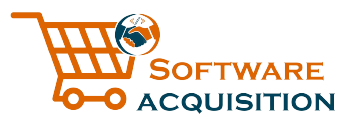Welcome to my friendly guide on understanding software acquisition methods and exploring effective strategies for your business in the U.S. market. In today’s digital age, software procurement plays a vital role in the success of organizations across industries. As technology continues to evolve rapidly, it is crucial for businesses to stay informed about different software acquisition methods and implement the best practices to drive efficiency and maximize value.
Key Takeaways:
- Software acquisition methods are essential for successful software procurement in the U.S. market.
- Tailoring the acquisition strategy to meet unique business needs is crucial.
- Technical reference frameworks (TRFs) offer flexibility in computing and infrastructure environments.
- The Software Acquisition pathway is a preferred option for acquiring software-intensive systems.
- The Urgent Capability Acquisition pathway and Middle Tier of Acquisition pathway provide alternative options for specific scenarios.
Overview of Software Acquisition Process
To ensure a successful software acquisition, it is essential to have a clear understanding of the overall process, including the planning and execution phases, as well as the different methods and techniques available for purchasing software. This section provides a comprehensive overview of the software acquisition process, highlighting key activities and considerations.
During the planning phase, strategic planning is crucial to define the objectives and requirements of the software acquisition. This involves identifying the software procurement strategies that align with the organization’s goals and selecting the most appropriate software purchase methods. It is important to gather all relevant information and assess the organization’s needs to ensure the chosen software aligns with the business requirements.
Once the planning phase is complete, the execution phase begins. This phase involves putting the plans into action by implementing the selected software acquisition methods and sourcing techniques. It may include activities such as negotiating contracts, evaluating vendors, and conducting pilot tests to ensure the software meets the organization’s requirements.
Table: Overview of Software Acquisition Process
| Phase | Activities |
|---|---|
| Planning | – Strategic planning – Identifying software procurement strategies – Selecting software purchase methods |
| Execution | – Implementing software acquisition methods – Sourcing techniques – Negotiating contracts – Evaluating vendors – Conducting pilot tests |
By following a systematic approach to software acquisition and considering the various methods and techniques available, organizations can enhance their chances of success. It is important to tailor the acquisition strategy to the unique needs of the business and leverage technical reference frameworks (TRFs) to create flexible computing and infrastructure environments.
Next, we will delve into the importance of tailoring the acquisition strategy to meet specific business needs in Section 3: Tailoring the Acquisition Strategy.
Tailoring the Acquisition Strategy
To maximize the benefits of software acquisition, it is crucial to tailor the strategy to your business’s specific requirements, considering factors such as the selection process, vendor evaluation, and industry best practices. By customizing the acquisition strategy, you can ensure that the software you acquire aligns perfectly with your organization’s needs and goals.
When it comes to the selection process, conducting thorough research and analysis is essential. Carefully assess your business’s needs and objectives, taking into account factors such as scalability, compatibility, and functionality. This will help you identify the software that best meets your unique requirements and ensure a successful implementation.
Vendor evaluation is another critical aspect of the acquisition strategy. It is important to assess potential software vendors based on factors such as reputation, expertise, support and maintenance capabilities, and alignment with your organization’s values and culture. This evaluation process will help you choose a reliable and trustworthy vendor that can meet your long-term software needs.
Industry best practices
Implementing industry best practices can significantly enhance the success of your software procurement process. This includes adhering to recognized standards, following established guidelines, and staying updated with the latest trends and advancements in software acquisition. Incorporating these practices into your strategy will help streamline the procurement process, minimize risks, and ensure optimal outcomes.
In summary, tailoring the acquisition strategy is crucial for successful software procurement. By considering factors such as the selection process, vendor evaluation, and industry best practices, businesses can optimize their software acquisition journey and unlock the full potential of their investments.
| Factors to Consider | Actions to Take |
|---|---|
| Selection Process | – Conduct thorough research and analysis – Assess scalability, compatibility, and functionality – Identify software that aligns with business needs and goals |
| Vendor Evaluation | – Evaluate reputation, expertise, support, and maintenance capabilities – Assess alignment with organizational values and culture |
| Industry Best Practices | – Adhere to recognized standards – Follow established guidelines – Stay updated with the latest trends and advancements |
Technical Reference Frameworks for Flexibility
Incorporating technical reference frameworks (TRFs) into your software acquisition strategy can provide the necessary flexibility in computing and infrastructure, ensuring optimal procurement outcomes. TRFs are a set of guidelines and best practices that help organizations make informed decisions when acquiring software. They offer a structured approach to evaluating software solutions and can be customized to meet specific business needs.
By utilizing TRFs, businesses can streamline the software selection process and make more informed decisions. TRFs provide a framework for evaluating software licensing models, which is crucial for ensuring compliance and cost-effectiveness. With different licensing models available, such as perpetual licenses, subscription-based models, or usage-based models, TRFs can help businesses choose the most suitable licensing option based on their unique requirements and budget.
Another benefit of TRFs is their role in aligning software procurement with industry best practices. They provide a structured framework for evaluating vendor capabilities, product quality, and support services. This ensures that businesses partner with reputable vendors and acquire software that meets their functional and technical requirements.
Table 4.1: Comparison of Software Licensing Models
| Licensing Model | Definition | Advantages | Disadvantages |
|---|---|---|---|
| Perpetual License | A one-time payment for lifetime use | – Full control over the software – No recurring fees |
– High upfront cost – Limited flexibility |
| Subscription-based Model | Payment based on a recurring subscription | – Lower upfront cost – Access to updates and support |
– Ongoing expenses – Dependency on vendor |
| Usage-based Model | Payment based on usage or consumption | – Pay only for what is used – Scalable pricing |
– Difficult cost estimation – Potential for unexpected expenses |
Implementing TRFs in the software selection process can also help businesses identify potential risks and mitigate them effectively. By considering factors such as vendor stability, product roadmap, and data security, organizations can make informed decisions that align with their risk appetite and prioritize system security.
In summary, technical reference frameworks provide a structured approach to software acquisition and offer flexibility in computing and infrastructure. By incorporating TRFs into your software procurement strategy, you can make informed decisions, align with industry best practices, and optimize your software acquisition process.
Software Acquisition Pathway
The Software Acquisition pathway stands out as a preferred choice for organizations seeking to acquire software-intensive systems, offering effective methods for successful procurement. This pathway allows businesses to carefully evaluate and select software solutions that align with their specific requirements and goals. By following the Software Acquisition pathway, organizations can ensure they make informed decisions and minimize the risks associated with software acquisition.
Benefits of Software Acquisition Pathway:
- Thorough evaluation of software options: The Software Acquisition pathway allows organizations to thoroughly evaluate different software options before making a final decision. This ensures that businesses select a solution that best meets their unique needs and requirements.
- Strategic planning and requirements gathering: This pathway emphasizes the importance of strategic planning and requirements gathering. By clearly defining the objectives, functionalities, and specifications of the software, businesses can streamline the procurement process and avoid costly mistakes.
- Vendor negotiation and contract management: The Software Acquisition pathway also includes vendor negotiation and contract management. This ensures that organizations secure the best possible terms and conditions, protecting their interests and maximizing value for money.
- Effective implementation and post-implementation support: Finally, the Software Acquisition pathway incorporates effective implementation and post-implementation support. This enables businesses to smoothly transition to the new software solution and receive ongoing support to address any issues or challenges that may arise.
Overall, the Software Acquisition pathway offers a structured approach to software procurement, enabling organizations to acquire software-intensive systems in a controlled and efficient manner. By leveraging the benefits of this pathway, businesses can optimize their software acquisition strategies and enhance their overall operational efficiency and effectiveness.
| Software Acquisition Pathway | Description |
|---|---|
| Thorough evaluation of software options | This step involves evaluating different software options based on specific criteria such as functionality, scalability, and compatibility with existing systems. |
| Strategic planning and requirements gathering | Organizations need to define their objectives, requirements, and specifications for the software. This step helps in aligning the acquisition process with the organization’s goals. |
| Vendor negotiation and contract management | Once the software option is chosen, organizations engage in negotiations with the vendor to secure favorable terms and conditions. This step includes contract management to protect the organization’s interests. |
| Effective implementation and post-implementation support | The final step involves the implementation of the software solution and providing ongoing support to address any issues or challenges that arise during and after the implementation process. |
Urgent Capability Acquisition Pathway
In urgent situations that demand immediate software acquisition, the Urgent Capability Acquisition pathway provides an alternative option with its own set of effective methods. This pathway is designed to expedite the procurement process and ensure that critical software needs are met promptly.
One of the key methods within this pathway is the use of emergency contracting. This allows organizations to bypass traditional procurement procedures and quickly engage with vendors who can provide the required software solution. Emergency contracting can significantly reduce the time it takes to acquire software, enabling businesses to address urgent needs and maintain continuity.
Another effective method in the Urgent Capability Acquisition pathway is the utilization of pre-approved vendors. By establishing a list of pre-approved vendors, organizations can streamline the selection process and quickly engage with trusted suppliers. This approach minimizes the time spent on vendor evaluation and allows for faster software acquisition.
| Benefits of the Urgent Capability Acquisition Pathway |
|---|
| 1. Rapid software acquisition to address urgent needs |
| 2. Bypassing traditional procurement procedures |
| 3. Utilization of pre-approved vendors for faster selection |
| 4. Ensuring continuity in critical software operations |
While the Urgent Capability Acquisition pathway offers a swift solution for immediate software acquisition, it is important to note that it may not be suitable for all scenarios. This pathway is best suited for urgent situations where time is of the essence and the need for software is critical. Organizations should carefully assess the urgency of their requirements and consider the potential impact on long-term software strategy.
Middle Tier of Acquisition Pathway
The Middle Tier of Acquisition pathway offers a suitable option for certain software acquisition scenarios, providing a range of effective methods to achieve successful procurement outcomes. This pathway is designed to cater to programs that require a balance between the urgency of the Urgent Capability Acquisition pathway and the complexity of the Software Acquisition pathway.
One of the key advantages of the Middle Tier of Acquisition pathway is its flexibility. It allows for agile development and incremental software releases, ensuring that programs can adapt to changing requirements and incorporate user feedback throughout the process. This approach not only reduces the risk of costly delays and rework but also ensures that software is delivered incrementally, enabling early benefits realization.
Within the Middle Tier of Acquisition pathway, there are several effective methods that can be employed. These include leveraging existing software assets, exploring commercial-off-the-shelf (COTS) solutions, and engaging with non-traditional vendors such as start-ups and small businesses. By considering these methods, programs can tap into a wide range of expertise and capabilities, enhancing the chances of finding the most suitable software solution.
| Advantages of Middle Tier of Acquisition Pathway |
|---|
| Flexibility for agile development and incremental releases |
| Risk reduction and early benefits realization |
| Utilization of existing assets and exploration of COTS solutions |
| Access to a diverse range of expertise and capabilities |
Example of a Middle Tier of Acquisition Pathway
- Conduct a thorough analysis of existing software assets and determine if any can be leveraged or repurposed for the program’s needs.
- Explore available COTS solutions that align with the program’s requirements and evaluate their suitability in terms of functionality, cost, and integration capabilities.
- Engage with non-traditional vendors such as start-ups and small businesses, who may offer innovative software solutions that address unique program needs.
- Apply an agile development approach, focusing on incremental releases and incorporating user feedback to ensure the software meets evolving requirements.
“The Middle Tier of Acquisition pathway provides a balanced approach to software acquisition, combining flexibility, risk reduction, and access to a diverse range of solutions and expertise.” – [Your Name], Software Acquisition Specialist
The Middle Tier of Acquisition pathway presents a valuable alternative for programs seeking effective software acquisition methods. By leveraging existing assets, exploring COTS solutions, engaging with non-traditional vendors, and employing agile development practices, programs can successfully procure software that meets their specific needs. This pathway emphasizes adaptability and incremental progress, allowing programs to mitigate risks and realize benefits early on. With careful planning and evaluation, the Middle Tier of Acquisition pathway offers a strategic and efficient approach to software procurement.
Activities in the Planning Phase
The planning phase of software acquisition involves crucial activities such as strategic planning, requirements gathering, and the meticulous software selection process to ensure the successful procurement of the most suitable software.
Strategic planning is the foundation of a successful software acquisition strategy. It involves identifying the organization’s objectives, assessing the current software landscape, and defining the desired outcomes. By aligning the software acquisition goals with the overall business strategy, organizations can ensure that the acquired software will meet their long-term needs.
Requirements gathering is a critical step in the planning phase as it helps identify the specific features and functionalities that the software must have. This involves engaging with stakeholders, conducting interviews, and performing needs assessments to capture all the necessary requirements. By clearly defining the requirements upfront, organizations can streamline the software selection process and avoid costly rework later on.
The software selection process is a meticulous exercise that involves evaluating multiple software options based on predetermined criteria. Organizations must consider factors such as functionality, scalability, compatibility, and cost when selecting the software. This process often involves creating evaluation matrices, conducting product demos, and engaging with software vendors to gather additional information. By carefully evaluating each option, organizations can ensure that they choose the most suitable software solution.
| Key Activities in the Planning Phase |
|---|
| Strategic Planning |
| Requirements Gathering |
| Software Selection Process |
In summary, the planning phase of software acquisition is a crucial step that sets the stage for a successful procurement process. Through strategic planning, requirements gathering, and a meticulous software selection process, organizations can ensure that they acquire the most suitable software solution to meet their objectives.
Activities in the Execution Phase
In the execution phase, successful software acquisition relies on the effective implementation of sourcing techniques and strategies, which play a vital role in achieving the desired procurement outcomes. This phase involves a series of activities that ensure a smooth transition from planning to the actual procurement of software.
One of the key activities in this phase is conducting market research to identify potential software vendors. This involves gathering information about various vendors, their offerings, and their track record in delivering quality software solutions. By carefully evaluating vendors based on their expertise, reliability, and cost-effectiveness, organizations can make informed decisions during the procurement process.
Another important aspect of the execution phase is the negotiation and contract management process. This involves engaging in negotiations with the selected vendor to finalize the terms and conditions of the procurement agreement. Negotiations may include aspects such as pricing, delivery timelines, support and maintenance, and any specific customization requirements. Effective contract management is crucial to ensure compliance with agreed-upon terms and to address any issues that may arise during the software implementation.
Key activities in the execution phase:
- Conduct market research to identify potential software vendors
- Negotiate and finalize the procurement agreement
- Manage the contract throughout the software implementation phase
- Monitor the progress of the procurement process and address any issues that arise
In summary, the execution phase of software acquisition involves implementing sourcing techniques and strategies to achieve successful procurement outcomes. By conducting thorough market research, negotiating favorable contracts, and effectively managing the implementation process, organizations can ensure the smooth acquisition of software and the realization of their desired outcomes.
| Activities in the Execution Phase |
|---|
| Conduct market research |
| Negotiate and finalize procurement agreement |
| Manage contract and implementation |
| Monitor progress and address issues |
Conclusion
Understanding software acquisition methods and implementing effective strategies is crucial for businesses seeking to optimize their software procurement process. By tailoring the acquisition strategy, considering technical reference frameworks, and exploring different pathways, businesses can successfully acquire the software they need to thrive in the U.S. market.
Throughout this friendly guide, we have provided a comprehensive understanding of software acquisition methods and highlighted the importance of tailoring the strategy to meet specific needs. The use of technical reference frameworks (TRFs) has been emphasized as a means to create flexible computing and infrastructure environments, enabling businesses to adapt and evolve seamlessly.
The Software Acquisition pathway emerges as the preferred option for acquiring software-intensive systems. However, the Urgent Capability Acquisition pathway and Middle Tier of Acquisition pathway offer additional alternatives for specific situations that require immediate software acquisition or have specific requirements. These pathways, combined with effective software procurement strategies and best practices, provide businesses with the tools and knowledge to make informed decisions in their software acquisition journey.
By following the outlined activities in the planning and execution phases, businesses can ensure a smooth and successful software acquisition process. Strategic planning, requirements gathering, and the careful evaluation of software vendors are vital steps in this journey. Additionally, effective software sourcing techniques and strategies help organizations implement their chosen software solutions seamlessly.
In conclusion, this friendly guide has provided businesses with the necessary insights and strategies to optimize their software acquisition process in the U.S. market. With a tailored acquisition strategy, consideration of technical reference frameworks, and exploration of different pathways, businesses can procure the software they need to drive their success and stay ahead in a competitive landscape.
FAQ
What is Understanding Software Acquisition Methods: A Friendly Guide?
Understanding Software Acquisition Methods: A Friendly Guide is a document that provides information on the process of acquiring software. It highlights the different activities involved in the planning and execution phases of software acquisition and explores various pathways for acquiring software-intensive systems.
Why is tailoring the acquisition strategy important?
Tailoring the acquisition strategy is crucial because it allows businesses to meet their unique needs and requirements. By customizing the strategy, businesses can ensure that they select the most suitable software and vendor, leading to successful software procurement.
What are technical reference frameworks (TRFs) and why are they important?
Technical reference frameworks (TRFs) are tools that provide flexible computing and infrastructure environments. They play a significant role in software procurement by guiding businesses in selecting the appropriate software licensing models and ensuring compliance with best practices.
What is the Software Acquisition pathway?
The Software Acquisition pathway is a preferred option for acquiring software-intensive systems. It involves strategic planning, requirements gathering, vendor evaluation, and software selection. This pathway provides a structured approach to software acquisition.
When should the Urgent Capability Acquisition pathway be considered?
The Urgent Capability Acquisition pathway should be considered in situations requiring immediate software acquisition. It offers expedited processes and streamlined methods to quickly procure necessary software.
What is the Middle Tier of Acquisition pathway used for?
The Middle Tier of Acquisition pathway is another option for specific software acquisition scenarios. It allows businesses to acquire software through a mid-tier acquisition process, providing flexibility and tailored solutions.
What activities are involved in the planning phase?
The planning phase of software acquisition includes strategic planning, requirements gathering, market research, and the software selection process. These activities lay the foundation for successful software procurement.
What activities are involved in the execution phase?
The execution phase of software acquisition involves software sourcing, contract negotiation, implementation planning, and vendor management. These activities ensure the smooth implementation of the software.
Source Links
- https://www.fhwa.dot.gov/publications/research/operations/its/98036/rdsuccessvol2.pdf
- https://www.test-evaluation.osd.mil/Portals/120/Documents/TE Enterprise Guidebook/Ch5 from TE Enterprise Guidebook 8.02.pdf?ver=7g0ErIbnox_eSeN63K-KIQ==
- https://insights.sei.cmu.edu/blog/six-acquisition-pathways-for-large-scale-complex-systems/



